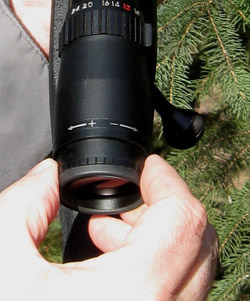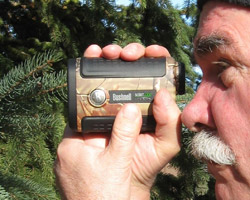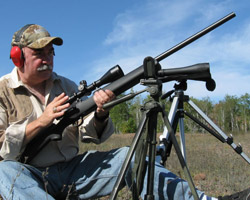Shooting Tips
Ten Components Of Precision Shooting
MA number of times I've been asked, "What must a precision rifle shooter know? What specific skills does he need to master?"
Here is the overlap of skills and knowledge I recommend to riflemen, presented as Ten Components:
 Properly mount and zero your scope, and refocus your reticle at least annually.
Properly mount and zero your scope, and refocus your reticle at least annually.- Properly Mount, Focus and Zero Your Scope: This is the foundation for accurate shooting. Incorrect eye relief precludes holding your rifle naturally with a proper cheek weld, while canting adds a degree of error that grows with distance. Zero your scope at exactly your intended distance -- usually 100 yards -- and at least yearly re-focus your reticle so it's crisp.
- Determine Your Most Accurate Load: Before I zero, I typically fire four or five different loads to find the most accurate one for that rifle. Accuracy differences can be profound, even among various match loads. If you're a handloader, try a variety of powders, bullets and muzzle velocities.
- Focus on Fundamentals: Practice Trigger Control by "educating" your finger to that specific trigger, especially through dry firing. (Use a Snap-Cap to preclude damaging your firing pin!) Perfect your Sight Picture -- the scope's entire field-of-view should be clear, with the crosshair centered. As your shot breaks, your eye is focused on the crosshair, not the target. For Breathing take a couple of deep breaths to oxygenate your blood, exhale normally, then, on a half-breath, during your natural respiratory pause, break your shot -- that's when your body is calmest. After firing, pause for a second and Follow-Through by continuing to look through your scope and breathe, then immediately run your bolt -- this helps maintain your mental focus right through the shot, while the habit of running the bolt ensures that you always have a round ready for a follow-on shot.
- Record Each Shot: Carefully record each shot in a Marksmanship Record Book. (A free Record Book form is posted on my website, ultimatesniper.com) This teaches you to focus on each shot as a one-time event, and enables you to analyze any inaccuracy. Fire no more than ten rounds per paper target, and "call" each shot -- that is, immediately after firing a shot, before eyeing the target, jot down where you THINK it impacted, then see exactly where it did impact and record it. Calling your shot will sensitize you to tiny errors as you break each shot.
- Master Range Estimation: The greatest cause of long-range misses is incorrect range estimation, which has a cumulative impact when compensating for distance, wind, target movement and uphill/downhill angle. Fight the temptation to round-off or snap-judge a distance such as 350 yards -- instead, narrow it to the closest five yards. I have several lasers and use them often, but mostly as a "de-liar" -- that is, FIRST I estimate the range using a technique such as the appearance of objects, or estimating half that distance and doubling it, or using football-field 100-yard increments. Only after that do I use a laser to determine how close my estimate was -- and if it was wrong, analyze how I went wrong.
- Learn to Estimate and Compensate for the Wind: So-called "doping the wind" is a long-range shooter's greatest challenge because it's part skill and part art. The best way to learn it is to do it. Electronic wind gauges are helpful, but they only measure the wind at your location -- I consider these devices a "yardstick" for comparing the wind around me to the wind downrange. Equally, know how the wind affects your projectile and (as a starting point) memorize the amount of wind drift at various distances and from various angles.
- Understand and Employ Minute-of-Angle Measurements: The basic increment of most American riflescopes is a fraction of a Minute-of-Angle, usually one-quarter of a Minute, which means one-quarter inch at 100 yards. Learn exactly what your scope's increments (or "clicks") equal, and how this increases with distance. (See my earlier column, "Mastering Your Target Knobs") Understanding MOAs is absolutely essential for using target knobs.
- Confirm the Trajectory of YOUR Rifle/Scope/Ammo Combination: Through brochures or websites, obtain your ammo manufacturer's exterior ballistics for your load -- especially the trajectory which shows how much your bullet drops at various distances, after zeroing at 100 or 200 yards. This is useful data but it's not "gospel" because it assumes a 24-inch barrel, shooting at sea level, in 59 degrees F., with a scope mounted one and one-half inches over the bore. The combination of YOUR rifle, YOUR scope and YOUR ammo may vary the trajectory a bit, which can only be measured by actually firing at various distances. Jot down these variances (preferably fired at 25 yard increments) so you know EXACTLY where your bullet will impact. (For more details, see my column on Preparing a Ballistic Data Card)
- Practice-Fire on Shooting Ranges AND in Field Conditions: Divide your live-fire practice between "Known Distance" firing from a bench or prone, and "Unknown Distance" firing in field conditions, which employs all body positions. I consider Known Distance firing only zero verification -- that is, it only confirms that my zero is correct and prepares me for realistic practice. Get off the shooting bench and practice the sitting, kneeling, squatting, prone and offhand positions. Firing at Unknown Distances integrates target detection, range estimation, body positions and marksmanship. I advocate shooting in inclement weather -- recall that Carlos Hathcock used to say, "It never rains on a rifle range." Keep it fun, using reactive targets such as clay pigeons, balloons and steel plates. And finally, I recommend focusing on "quality shots," rarely firing more than 20 rounds during a single practice session -- that way, each shot matters.
- Strive for Consistency: Accuracy follows consistency: Be consistent in everything you do, from how you hold your rifle to how you see the scope sight picture, break the shot, breathe -- everything. Develop the consciousness to diagnose the source of any error, then consistently apply the correction. The more consistently you operate, the more accurately you will shoot.
 Laser rangefinders are great -- but first estimate distances the old-fashioned way.
Laser rangefinders are great -- but first estimate distances the old-fashioned way. Shooting off a bench at known distances is OK for zeroing, but practice fire requires unknown distances in field conditions -- prone, sitting, standing and kneeling.
Shooting off a bench at known distances is OK for zeroing, but practice fire requires unknown distances in field conditions -- prone, sitting, standing and kneeling.Develop and hone these ten components and you will be a precision rifleman.
